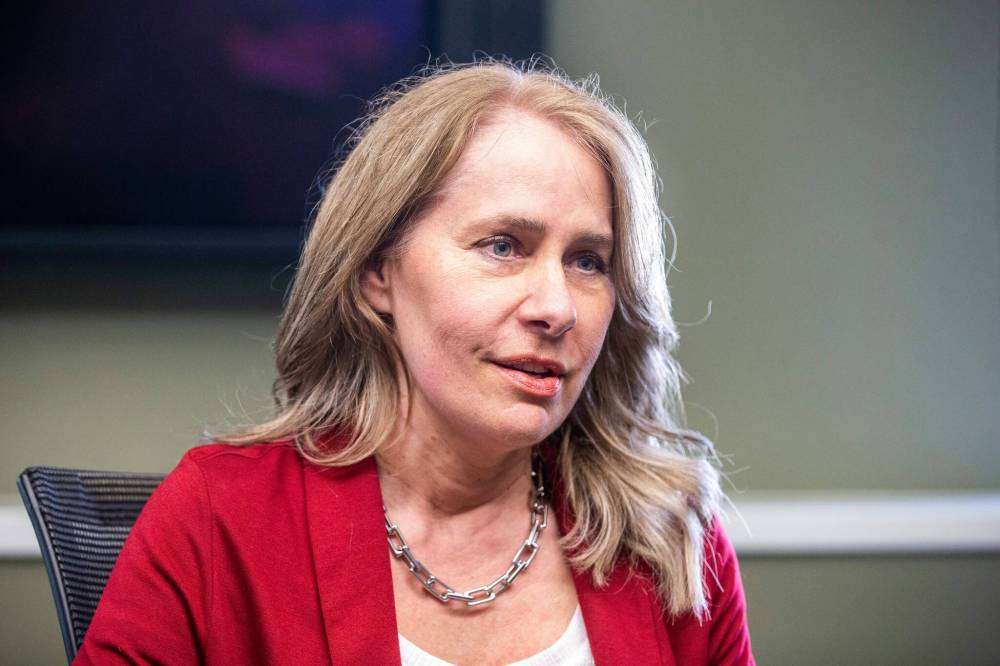Premier Wab Kinew vowed during last fall’s provincial election that if elected, an NDP government would shrink the size of the health-care bureaucracy and redirect resources to front-line care.
He reiterated that pledge the day after the NDP won the Oct. 3 election.
“One of the things we campaigned on… is to simplify the bureaucracy so there’s more resources for the front lines but also more empowerment, more decision-making on the front lines,” said Kinew.

MIKAELA MACKENZIE / FREE PRESS FILES
Lanette Siragusa, CEO of Shared Health, indicated cuts to Manitoba’s health-care bureaucracy will result in $1 million in savings. Columnist Tom Brodbeck believes it will do nothing to redirect resources to front-line care.
“I think a lot of health-care workers, whether they’re the physician, the nurse, the X-ray tech or the lab tech, they feel they’ve been infantilized by too much bureaucracy in the health-care system.”
So, how’s that going so far, after nearly seven months in government? Not great.
Shared Health, the largest government health-care bureaucracy in Manitoba, revealed this week that it has chopped 24 administrative positions from its ranks to comply with the NDP’s new mandate.
However, only 10 of the 24 bureaucrats in question no longer work for Shared Health. They accepted severance packages. The other 14 were redeployed to other so-called priority areas, a move that’s more of a shell game than a genuine effort to cut bureaucratic costs.
Shared Health CEO Lanette Siragusa said the changes will result in $1 million in savings.
That may seem like a lot of money, but it’s a drop in the bucket when it comes to government spending on health-care bureaucracy, which has skyrocketed in recent years.
As I documented in this column in November, Shared Health’s administrative costs ballooned to $118 million in 2022-23, up from $76 million the previous year. As a percentage of total operating spending, Shared Health’s bureaucratic costs soared to 7.77 per cent in 2022-23, up from 4.37 the previous year.
Part of the reason for that is Shared Health has taken on administrative functions from other health-care bureaucracies. However, there has not been a commensurate decline in administrative costs in other health authorities.
“Across Manitoba, within all service delivery organizations with the exception of Winnipeg Regional Health Authority, administrative costs increased as a percentage of total operating costs,” Shared Health reported in its 2022-23 annual report.
The administrative costs of all health authorities across the province jumped to $300.2 million in 2022-23, up from $260.6 million the previous year. That’s a 15 per cent increase in a single year.
As a percentage of total operating costs for all health authorities (including Shared Health), administrative spending increased in 2022-23 to 5.06 per cent from 4.28 per cent the previous year.
That all happened under the previous Progressive Conservative government. Resources that should have been earmarked for front-line services were instead lining the pockets of bureaucrats, such as former Shared Health CEO Adam Topp, who was paid $330,739 in 2022. Siragusa was paid $245,451 that year when she was the provincial lead for health services integration and quality. She replaced Topp as CEO in 2023. Compensation disclosure reports are not yet available for that year.
What the reports show is Shared Health employs hundreds of administrators, including senior bureaucrats paid more than $200,000, directors, executive directors, managers, analysts, co-ordinators, facilitators, media specialists, and the list goes on.
So when Shared Health says it has cut the bureaucracy by $1 million, it’s virtually meaningless. The organization’s administrative costs have more than tripled from $42.2 million in 2019-20 to $118.4 million in 2022-23. While some of that is the result of administrative functions that were transferred to Shared Health, overall administrative costs for all health authorities (including Shared Health) have increased 37 per cent from $218.5 million in 2019-20 to $300.2 million in 2022-23.
The $1-million “cut” to Shared Health’s bureaucracy is window dressing. It may give Kinew and Health Minister Uzoma Asagwara useful talking points when asked about the province’s bulging health-care bureaucracy. But it comes nowhere near satisfying the election commitment made by the NDP that it would shrink the size of the bureaucracy.
To do that, the NDP would have to cut tens of millions of dollars in bureaucratic spending from Shared Health and other government health authorities.
If it was serious about doing so, the government would set a target that administrative costs should not exceed a certain percentage of total operating spending. Such targets already exist under the Regional Health Authorities Act, but they include only corporate costs, not recruitment/human resources-related costs or patient-care administrative spending. It should include all bureaucratic costs.
Manitoba’s health-care bureaucracy needs to be slashed. Cutting it by $1 million does almost nothing to achieve that goal.
tom.brodbeck@freepress.mb.ca

Tom Brodbeck
Columnist
Tom Brodbeck is a columnist with the Free Press and has over 30 years experience in print media. He joined the Free Press in 2019. Born and raised in Montreal, Tom graduated from the University of Manitoba in 1993 with a Bachelor of Arts degree in economics and commerce. Read more about Tom.
Tom provides commentary and analysis on political and related issues at the municipal, provincial and federal level. His columns are built on research and coverage of local events. The Free Press’s editing team reviews Tom’s columns before they are posted online or published in print – part of the Free Press’s tradition, since 1872, of producing reliable independent journalism. Read more about Free Press’s history and mandate, and learn how our newsroom operates.
Our newsroom depends on a growing audience of readers to power our journalism. If you are not a paid reader, please consider becoming a subscriber.
Our newsroom depends on its audience of readers to power our journalism. Thank you for your support.